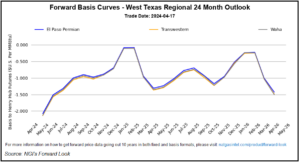Natural Gas Futures Continue Lower as Market Mulls ‘Just Ugly’ Storage Print
As analysts pointed to this week’s hefty storage injection as evidence of a loose market, natural gas futures extended their recent losses in early trading Friday. The expiring July Nymex contract was down 3.6 cents to $1.446/MMBtu at around 8:40 a.m. ET. August was off 1.2 cents to $1.534.

The U.S. Energy Information Administration (EIA) on Thursday reported a larger-than-expected injection of 120 Bcf for the week ending June 19. The build lifted inventories to 3,012 Bcf, well in excess of the year-earlier level of 2,273 Bcf and the five-year average of 2,546 Bcf. A week earlier, EIA reported a 93 Bcf injection.
Prior to the report, a Bloomberg poll found injection estimates ranging from 100 Bcf to 114 Bcf, with a median of 108 Bcf, while a Reuters survey produced a 90 Bcf to 115 Bcf injection range and a median of 106 Bcf. NGI estimated a 116 Bcf build.
“Compared to degree days and normal seasonality, the 120 Bcf injection appears loose by 2.5 Bcf/d versus the five-year average,” Genscape Inc. analyst Eric Fell said. “The trend of tighter weekly storage stats since the extreme Covid-related looseness in April has reversed in June, driven by a sharp decline” in liquefied natural gas feed gas demand, as well as “weaker weather-adjusted power demand driven by a large increase in renewable generation from abnormally low levels in April and May.”
Genscape is estimating a 1 Bcf/d year/year increase in power burns for June, despite a year/year increase of 32 cooling degree days.
“This means that June power burns are looking lower than last year on a weather-adjusted basis,” Fell said. “The surge in nuke/renewable generation and weaker weather-adjusted power loads versus last year are taking their toll on gas generation, even as lower gas prices continue to push coal utilization to record lows.”
Analysts at Tudor, Pickering, Holt & Co. (TPH) described this week’s plump storage print as “just ugly” for the natural gas market.
“Gas was already a runaway train this week, and yesterday’s storage report put a crate of dynamite on the tracks,” the TPH team said. “Expectations were bearish heading in, but the 120 Bcf print was materially worse than even the highest estimate, which dropped the floor on pricing.
“…As we’ve warned, warm weather has been propping up the gas market, but this trend reversed in a big way, as last week’s degree days were 30% below norms and even after adjusting for weather the build implies a 4 Bcf/d oversupplied market,” they said. “However, we see the market being much tighter than that, and expect this to be reflected in next week’s print, where normal weather is expected to drive a seasonally normal build of 70 Bcf.”
As for the latest weather outlook, Bespoke Weather Services observed hotter changes for the first third of July, with both the European and American weather models showing more heat across the Midwest and East.
“Highs into the 90s may grow common as far north as Chicago, Detroit and parts of the Northeast,” Bespoke said. “The lack of Atlantic blocking keeps the focus of above-normal heat out of the southern U.S., though temperatures are no worse than normal in this region.
“All of this adds up to a rather impressive look in terms of total national demand as we head toward the middle of summer, though given the importance of the South for the natural gas market, we’d like to see more southern heat to make the claim that it is optimal.”
August crude oil futures were down 49 cents to $38.23/bbl at around 8:40 a.m. ET, while July RBOB gasoline was off fractionally to $1.1892/gal.
© 2024 Natural Gas Intelligence. All rights reserved.
ISSN © 1532-1231 | ISSN © 2577-9877 |


